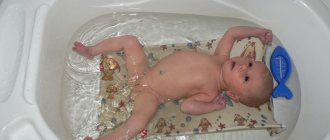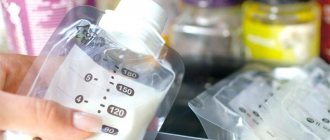The birth of a child is the most beautiful moment in a woman’s life. Everyone is preparing for this meeting and is really looking forward to it.
With the onset of pregnancy, the expectant mother’s body begins to rebuild. In the early stages, the breasts are already preparing for future feeding. It becomes sensitive, fills up and increases in size. In the later stages of pregnancy, droplets of milk sometimes appear on the nipples, but when it arrives after childbirth is a purely individual question.
What is colostrum
Colostrum is the substance secreted by the mammary glands during pregnancy and in the first postpartum days .
The process of its production begins at the end of the first to the beginning of the second trimester, when the breasts enlarge and become more sensitive. At this moment, the glands enlarge, and the ducts and tubules through which first the colostrum and then the milk are to flow become enlarged. In this way, the body prepares for the upcoming feeding of the baby.
Colostrum is necessary not only for preparing the mother’s body, but also for feeding the baby until milk comes in .
The first minutes after birth
The first attachment to the mother's breast should occur soon after the baby is born, regardless of the presence of milk. Thanks to this manipulation, it will be possible to fill the baby’s digestive organs with healing colostrum, as well as trigger the mechanisms in the young mother’s body that are responsible for milk production. It is also worth considering that breasts for a baby are a kind of sedative.
Do I need to supplement or supplement?
Nature itself intended that in the first days after childbirth, a woman secretes colostrum instead of milk. This is due to the fact that in the first hours the baby’s intestines are not ready to digest full-fledged breast milk. And the stomach, with a volume of approximately 7 ml, is enough to saturate a few drops of colostrum.
It is no coincidence that the baby is immediately put to the breast after birth. At this first meal, he sucks out about a teaspoon of colostrum. This is necessary to improve the baby’s immunity and prevent the development of infections. In addition, it has been proven that bottle-fed babies are more susceptible to allergic reactions than naturally fed babies.
Therefore, it is normal and natural for a child to eat only colostrum for the first 3-4 days. And the weight loss observed these days is inevitable. It also occurs with artificial feeding.
Colostrum and its functions
When does milk appear after childbirth in women? It is impossible to answer this question, but you definitely shouldn’t expect it immediately after the birth of your child. The first food for a newborn is colostrum - a thick yellowish liquid that is produced in small quantities in the mammary glands.
There is no need to worry that the child will remain hungry, nature has provided for everything. The newborn’s intestines are not ready to immediately accept nutritious food. Thanks to colostrum, it is possible to launch the milk digestion mechanism, enriching the microflora of the digestive system with beneficial bacteria.
It is interesting to know that just a few drops of colostrum can create optimal intestinal microflora. Immune bodies and antioxidants included in its composition prevent the development of allergies, as well as the entry of pathogenic bacteria into the body.
Colostrum is high in protein and is 2.5 times more caloric than milk. The baby's stomach volume at the time of birth is approximately 7 ml, so he does not need a lot of food. The volume of colostrum production in women also varies from person to person. On average, its amount varies from a few drops to 100 g per day.
Colostrum has a mild laxative effect on the baby’s body: it prepares the body for the transition to breast milk, cleanses the gastrointestinal tract, and also frees the intestines from original feces. Bilirubin is actively removed from the body, which contributes to the development of jaundice.
Thanks to colostrum, the newborn’s passive immune system is formed, acquired without suffering illnesses. The introduction of the mixture entails the development of dysbiosis and causes an imbalance in the natural intestinal microflora. Once milk appears, the baby will be ready to digest it.
When does milk appear after childbirth?
The appearance of milk depends on a number of factors:
- was the pregnancy full-term or premature;
- the birth occurred naturally or by caesarean section;
- first or second birth.
On what day does milk come in after childbirth? The norm for the first pregnancy is the absence of milk in the first 2 days, then thick yellowish milk appears. There is slightly more of it than colostrum. And the so-called real milk comes only on days 3–5 . The night before, the breasts increase sharply, begin to hurt and become hard. There may be so much milk that has arrived that the nipples become flat and the baby cannot take them.
With repeated births, milk comes faster, the breasts no longer react so painfully and do not increase as much. The appearance of milk is necessarily accompanied by an increase in local temperature, that is, the breast becomes very hot.
With a caesarean section, if it was successful and the baby was born to term, the milk comes in at about the same time. That is, for 3–5 days. But if a cesarean section was performed during a premature pregnancy, then the body will have to spend more energy on recovery. Therefore, milk may come in a week, or sometimes disappear altogether. Even doctors will not be able to accurately determine the timing in this case.
The most important first days of feeding
In the first days, mother and baby adapt to each other. And first of all in terms of feeding. Today, many maternity hospitals have wards where mother and child are constantly together. This provides an excellent opportunity to improve the process of feeding a newborn. However, you will need to take into account the following nuances:
- The milk will arrive gradually, and the more often you put the baby to the breast, the faster its volume will increase. feeding the baby on demand at this time
- It is necessary to properly attach the baby to the breast . The baby should grasp the entire nipple, and the mother should not experience discomfort. Then the baby will receive enough milk, and the woman will avoid the formation of cracks in the nipples.
- Be sure to learn from the very first days to help the baby burp air , which he will swallow even with proper feeding. It is best to place the baby vertically against your shoulder.
Problems with lactation
There are many reasons for the lack of milk and this process requires detailed consideration. If you are concerned about his prolonged absence, you should consult with competent specialists. As a rule, the reasons for the lack of milk are the following factors:
- Early introduction of formulas in the maternity hospital;
- Rarely attaching the baby to the breast, feeding on a schedule;
- Fluid deficiency in a woman’s body;
- Poor nutrition of a young mother;
- Strong emotional stress, stress;
- Hormonal disbalance;
- Surgical intervention.
It does not matter when full lactation begins. It is extremely important to preserve it and provide the mother with adequate nutrition so that the baby is provided with all the necessary vitamins and minerals. If a newborn does not have enough food, the following factors may indicate this:
- Significant reduction in milk production;
- Restless behavior of the newborn;
- Small weight gain;
- The baby urinates less than 8 times during the day.
Soon after giving birth, a young mother should establish contact with her baby and make every effort to ensure that the breastfeeding process brings benefit and pleasure to everyone. There is no need to worry that the baby is hungry until the milk appears; he still has enough colostrum.
How to properly attach a baby to the breast
In order for the baby to be fully nourished, it must be properly applied to the breast. And to do this you need to follow a few simple rules:
- Choose a position that is comfortable for you. You can sit or lie down, use pillows or soft bolsters that will support your tired back or arm.
- The baby should press his whole body tightly against his mother. You should not place your baby on his back; the best position is on his side. The child's head, back and legs should be at the same level. It is important to monitor the position of the neck - the baby will not be able to swallow if it is not straight.
- Do not force your baby to your breast. You just need to point him in the direction and hold his shoulders and back, but don’t put pressure on his head.
- It is advisable that during feeding the baby's skin is in close contact with the mother's skin . This helps strengthen the bond between mother and baby and also increases milk supply.
Conclusion
Any woman, when deciding to become a mother, initially gives a part of herself to her child and takes great responsibility for him. Therefore, taking care of your health, as well as the health of your baby, is the sacred duty of a mother. And of course, one of the important factors in the future health of a child is nutrition, from the first days of life. And the better the mother feels, the better her baby will be.
Feeding frequency and whether to express
In the first days, when the milk has not yet come, the baby is fed on demand . At the same time, he may ask for food often - every 30-40 minutes, or rarely - only a few times a day. During this period there are no clear feeding times.
After milk appears, the baby begins to suckle at the breast with a certain frequency. Usually every hour or hour and a half during the day and 3-5 times at night. The child controls the feeding process himself. However, if the baby sleeps a lot and rarely eats, then you can put him to the chest while sleeping. Babies also nurse while they sleep.
There is no need to express milk if you are feeding on demand. On the first day more of it will come, but the very next day its volume will be exactly what the child needs to be full. Therefore, you cannot express milk on the first day , otherwise more and more milk will appear.
What to do to make milk come faster. Not enough milk. What can I do to get more milk?
The main thing is that it is important for you to correctly assess whether you really have little milk. And if you are convinced of this, then you need to know what to do to get more milk. So, let's begin…
Step one. Find out if the baby has enough milk
- How to check?
- Weighing. Weight gain of less than 500 g per month, less than 120 g per week is an indication that you actually have little milk
- Wet diaper test. The number of urinations less than 8 per day is critical. Only well-wetted diapers are counted.
Cases when a baby does not have enough breast milk are not that common. Much more often, mothers feel that their child has been suckling for too long or that someone (mother-in-law, doctor, neighbor on the street, etc.) told them that they have little milk.
Sometimes, women who could breastfeed without any problems lose milk simply because they do not have enough knowledge about breastfeeding
Step two. Not enough milk
- If you are convinced that the baby actually does not have enough milk, answer the following questions before taking action:
- Do you feed your baby on demand and how many times a day?
- Does the baby eat at night? Where does he sleep?
- Do you use nipples and a bottle? Do you provide water?
- Maybe you have already started supplementing with formula? In what quantity and how many times a day do you feed the formula?
- Monitor your condition while feeding your baby. It often happens that a woman becomes very tense during feeding due to an uncomfortable position or because of the fear that there is again little milk in her breast and the baby will not be satisfied again.
- How do you eat? Are you drinking enough fluids?
- Observe what time of day your milk production is minimal.
- What is the emotional situation in your family? Are there people around you who do not support the idea of breastfeeding?
Step three. Little milk, increase lactation
To get detailed information on how to increase lactation, use our bot assistant in Telegram. To use the Telegram bot, just type @mamalarabot in the search bar of the messenger and click the Start button.
Step four. Increasing lactation with lactogonic agents
To increase lactation, use lactogenic agents: anise seeds, fennel seeds, nettle, homeopathic remedy lactatosan, apilak.
Step five. Increasing lactation with massage
Massage regularly with special oil “for breasts during lactation” or any vegetable oil with the addition of fennel or anise essential oil.
Also do a chest massage to restore lymphatic drainage, shown in our
Step six. Not enough milk. Weighing
Avoid frequently weighing your child. Do this no more than once a week.
Step seven. Not enough milk. Walks
Don't walk for a few days, especially if it's cold outside. After all, getting ready for a walk is often associated with stress. The baby is yelling, mom is in a hurry. And any stress is contraindicated for a breastfeeding mother, especially if she has little milk. Now you need to direct all your efforts to increase lactation and solve the problem with breast milk.
IF YOU HAVE LITTLE MILK, I WISH YOU NOT TO LOSE HOPE. YOU WILL DEFINITELY BE ABLE TO BREASTFEEDING!
How to prevent milk from disappearing
There are times when a woman’s milk disappears. To avoid this or minimize the risk, you must follow a few simple rules:
- Avoid stressful situations. Very often milk disappears due to nervousness. Therefore, a nursing mother should experience only positive emotions.
- Eat well. During the day, eat 5-6 times and drink plenty of fluids.
- Place your baby on the breast where your milk supply is decreasing.
- Make sure your baby latches onto the breast correctly and fully latches onto the nipple.
- Massage your breasts several times a day using olive oil. Take a contrast shower in the morning and evening.
- Rest as often as possible. Fatigue can also cause milk to decrease and disappear.
- Do not take birth control pills, as the hormones they contain have a negative effect on lactation.
- Avoid getting sick. Even a common cold can cause milk production to stop.
- Feed your baby as often as possible. Be sure to do this at night as well.
Breast device
The mammary glands are designed to feed the baby with milk until he can feed himself. The body of each gland is a dense disk consisting of convex cone-shaped lobes. There are from 15 to 20 of them. Each lobe has smaller formations, which in turn are divided into alveoli.
It is the alveoli that serve to produce milk. Ducts come from them, through which, under the influence of muscle contractions, milk flows to the woman’s nipples. In addition, each milk duct has special reservoirs - sinuses - where breast milk accumulates.
The shape and size of breasts are different for every woman. This circumstance in no way affects the amount of milk produced.
The mammary glands have protective tissue; the shape of the breast depends on its elasticity. The size of the mammary glands is directly related to the amount of breast fat in them, and this does not affect lactation at all.
What to do if there is no milk after childbirth
Here are some tips to help promote milk production:
- Place your baby on both breasts alternately as often as possible.
- Drink plenty of fluids (at least 2-3 liters per day).
- Strictly monitor your diet; your body should not lack vitamins and minerals.
- Make sure you attach your baby to the breast correctly.
Precautionary measures
With the arrival of milk, the woman begins to experience unpleasant bursting sensations in the chest. To avoid them, as well as to prevent the formation of lactostasis, experts advise adhering to the following simple recommendations:
- If you begin to feel thirsty during feeding, drink purified water without additives;
- Feed often, but not for long. In the first days of lactation, the breasts are tested. In 15 minutes the child will have enough time to get enough;
- Relieve chest tension through breastfeeding. If it is very full, then place the newborn on it. The situation will ease naturally. If the baby is sleeping at this time, then express a small amount of milk. If you overdo it, you will produce even more of it!
- Do not drink a lot of fluids until breastfeeding is established. Excess fluid in the body will lead to greater tissue swelling.
Complications during breastfeeding
There are cases when breastfeeding causes certain complications:
- Breast engorgement. Occurs as a result of breast overfilling with milk. Usually happens on the first day after milk appears.
- Nipple cracking. Occurs due to improper positioning of the baby to the breast.
- Blockage of the milk ducts . Massage and warm compresses help a lot. It is recommended to try changing your feeding position.
- Mastitis. It is a consequence of blockage of the milk ducts and engorgement of the mammary glands. May lead to infection.
Video about the appearance of milk after childbirth
The video talks about what colostrum is needed for and when milk comes in. Much attention is paid to the description of the first days after childbirth, as well as myths about breastfeeding.
We recommend reading:
- How long does bleeding last after childbirth What can and cannot be eaten after childbirth After childbirth, hair falls out a lot: what to do When menstruation begins after childbirth while breastfeeding











